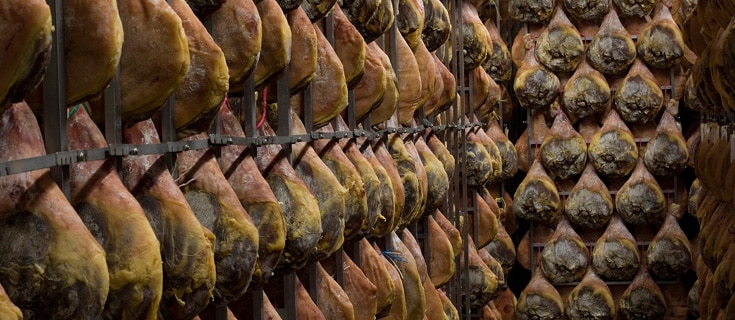Elaboration
Bayonne ham is produced according to traditional principles implemented and adjusted by the salaisonniers during the different stages:
1
Salting: during the cold winter months
the whole fresh hams are rubbed, one by one, with Salies-de-Béarn salt. They are then covered with a thick layer of salt and placed in a cold and humid room allowing for the salt to seep in.

2
Rest: cool, in the cellar
Once the salting is completed, the hams are suspended in the rest room. A resting period which at first recreates the winter conditions. This is then followed by a more spring like air with softer temperatures. This step is when the drying of the ham really begins.
3
Drying: hanging on the beam
The hams are then placed in the dryers where the long maturation process takes place in order to maximize the development of the flavor, aroma and softness of the ham. It’s summer.
4
Le pannage : en attendant d’être consommé
Le pannage (application sur les parties musculaires du jambon d’un mélange de graisse de porc et de farine) permet un séchage plus doux pendant la longue période d’affinage.
5
The pannage: waiting to be consumed
The “pannage” (application on the muscle parts of a mixture of ham, pork fat and flour) slows down the drying process during the long period of ripening helping the ham keep a soft and supple texture.

6
The poll
At the end of the ripening period, hams are subjected to the judgment of the « noses » which will define their taste qualities. For this, the cured meatman use probes that have the characteristics of capturing the smell of ham.

7
Marked with the Lauburu, the « Bayonne » seal
The physicochemical, microbiological and organoleptic characteristics of Bayonne Hams are regularly checked by approved laboratories. The seal « Bayonne », the Lauburu, or Basque cross, is affixed with a red iron on the hams who have successfully passed all the various selection stages and in particular the sounding.

INFOS NUTRITION
Bayonne ham has nutritional qualities that many other products could envy.
First this ham is 100% natural.
Bayonne ham is mainly distinguished by its contributions of vitamins of the B group and more particularly by its exceptional richness in vitamins B1 of which it is one of the best food sources.
Vitamin B1 is an antioxidant of polyunsaturated fatty acids. Its role is to protect cell membranes and fight cell aging. 100g of Bayonne Ham provide 70 to 80% of the Recommended Daily Allowances for an adult.
Lipids
The nutritional aspect of Bayonne ham as a source of essential fatty acids is too often overlooked. The Omega 6 fatty acids contained in the fat of Bayonne ham are essential for the growth of the child and the regeneration of the skin.
Half the fat of Bayonne ham is oleic acid, the main fatty acid of olive oil, good for health.
Bayonne ham is relatively low in cholesterol.
Abundant and quality proteins
Bayonne ham is an important source of protein. Its protein content is 23g per 100g. And 150g of Bayonne Ham covers about 45% of the Recommended Daily Intakes of Protein from an Adult.
Bayonne ham has a protein / calorie ratio which is particularly favorable for our health.

